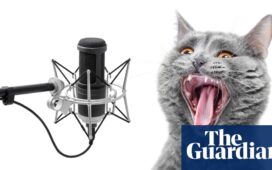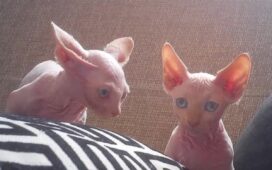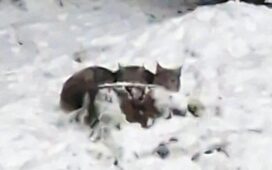The fruit flies that hover around the apples on your counter have to navigate a cluttered environment to find that food, from the built environment and vegetation around your house to the objects in your kitchen. Desert fruit flies, not so much. They fly through a mostly barren landscape dotted with a much smaller number of relatively predictable obstacles to find cactus fruit. Nonetheless, it has long been believed that other species of fruit fly navigate and maintain balance the same way as urban fruit flies, regardless of habitat.
A new study contradicts that belief with the discovery that species of flies living in the two distinct visual habitats have significantly different navigation tactics. The researchers made the discovery by putting fruit flies in a contraption that let them interact with virtual objects in a manner similar to the holodeck on the TV show “Star Trek: The Next Generation.”
Flying fruit flies have two jobs: to head toward interesting things, but also stay steady during flight. As in humans, vision helps them move straight and stay stable while orienting toward enticing objects. These two tasks are not complementary. Looking at interesting things interrupts the vision needed to stay stable. But the brain manages to process visual signals in such a way that the flies can accomplish both tasks.
“Visual stability is important — try to stand on one foot with your eyes closed,” said Mark Frye, the corresponding author of a paper published in Current Biology and a professor of integrative biology and physiology at UCLA. “If you want to look at interesting things, you have to briefly override the part of your vision that directs balance, and you risk falling over.”
Urban fruit flies, Drosophila melanogaster, live in a rich visual environment and can stabilize the background surrounding the objects around which they need to orient themselves. But in the desert, what few objects Mojave fruit flies, Drosophila mojavensis, encounter are likely to be the ones they are interested in, such as cactuses, but they also compose the scenery they need to use to stay stable.
To test how different environments affected the balance between navigation and stability in both species, the researchers devised a system that let the flies interact with virtual objects while tracking their body and eye movements with a camera. They glued a tiny steel pin to the fly’s back and connected it to a magnet suspended from the top of a round, drum-like device. Another magnet at the bottom of the drum created a magnetic field that held the pin exactly in position, while allowing the fly to rotate on the horizontal plane within the drum.
The walls of the drum were completely covered with LED lights and a computer created different moving shapes in various sizes and orientations using the lights. The fly could choose how to interact with these virtual objects. One of the objects was a vertical bar that looked like a natural feature, such as a tree trunk. This was designed to test how the fly would use the bar and background to navigate.
“We know exactly where she’s looking at because we’re tracking her body and head with a video camera. We also control exactly what the LED visual display is doing so we can recreate the fly’s eye view of the experiment,” Frye said.
The desert flies ignored the background and steered to smoothly follow the bar, centering it on their visual midline, while the urban flies did not. Desert and urban flies alike made rapid eye movements, called saccades, to follow objects that moved along a continuous path. Desert flies, however, relied more heavily on smooth fixation of the vertical bar, followed up by a flurry of saccades to catch up with fast-moving bars.
This pattern is similar to how our own eyes track moving objects.
“When our eyes track a fast-moving object, like a cow passing us by from a boring train ride, we tend to see smooth continuous eye movements, but only if the object is moving slowly relative to us. As we speed by faster, our eyes switch to rapid saccades to keep up,” said Martha Rimniceanu, a doctoral candidate at UCLA and the lead author of the study. “We were excited to find different use of smooth eye movements and saccades in closely related fly species. We believe this is an adaptation for the structure of their native visual environment.”
The desert flies responded to the bar moving across a stationary background by employing a ‘fixate and saccade’ strategy to track the bar smoothly. Urban flies smoothly fixated on the background, not the bar, and oriented toward the bar with saccades that overrode smooth stability.
“Basically, the desert flies fixate on the bar for balance and stability while also orienting toward it as an interesting object. The urban flies smoothly fixated on the background for balance, then used rapid saccades exclusively to navigate toward the bar,” Frye said.
The research showed that regardless of whether two species are closely related or not, their visual environment determined their visual navigation tactics.
Fruit flies are often used in experiments probing visual perception and processing. The finding that not all species of fruit fly navigate their environment the same way expands the possibilities for what scientists can learn. Desert fruit fly visual navigation more closely resembles that of humans than the urban fruit fly does, for example, and they could be used as a model for learning more about vision in humans. The information can also be used to aid development of autonomous vehicles.
“We can tailor research to the questions we have, rather than being limited to what the fly will give us,” Frye said.














